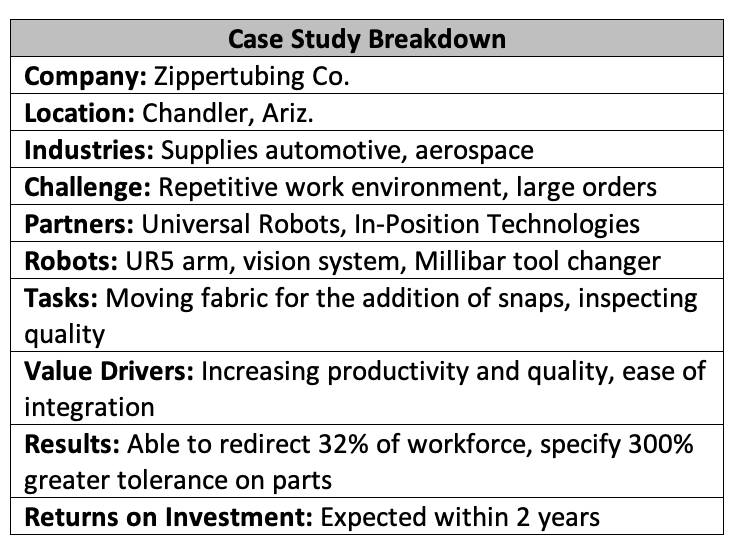CHANDLER, Ariz. — The Zippertubing Company makes shielding for electromagnetic interference, as well as specialized heat shrink, cable bundling, heat shielding, and marine fairing products. It needed to increase quality and throughput amid a shortage of skilled workers.
The family company had no prior robotics experience. Zippertubing ultimately turned to a UR5 collaborative robot arm from Universal Robots A/S to tend its snap-set cable wrapping machines.
Challenges
In 2017, Zippertubing struggled with finding human workers so that it could fill a large automotive order, reported The New York Times. The company also serves the aerospace industry.
 “We had a lot of people who would come in, work for maybe a week, and then leave because they didn’t like the repetitive work environment,” said Tim Mead, operations manager at Zippertubing.
“We had a lot of people who would come in, work for maybe a week, and then leave because they didn’t like the repetitive work environment,” said Tim Mead, operations manager at Zippertubing.
In addition, the repetitive nature of the work, which required looking at thousands of parts per day, could lead employees to be “snow-blind” to flaws, he said.
Some robot manufacturers directed Mead to integrators, “but we wanted something that we could integrate ourselves,” he said. “Something that would save us a lot of money and bring the installation down to a price point that made sense for us.”
Mead’s background is in chemical engineering, so he was initially reluctant to build a cobot cell himself. However, a distributor and the Universal Robots Academy helped him.
“The demo convincing us was done by Universal Robots’ distributor In-Position Technologies, and it looked very straightforward,” recalled Mead. “There’s also a lot of cool training stuff on the UR website.”
Solution
“We chose Universal Robots’ UR5 for a few reasons,” said Matt Hesselbacher, engineering manager at Zippertubing. “After a quick demo, we realized this was a collaborative robot we could integrate on our own.”
“With products that change from month to month, we were also looking at the versatility,” he said. “As always, safety was a priority, as operators would be working around the robot, feeding it raw parts, and taking away the finished pieces.”
Zippertubing’s snap-set machines wrap thermal materials around cables, hoses, and pipes. To tend them, the UR5 needs machine vision to make the right decisions.
“The really tricky part was ‘How do I get the robot to talk to the camera, and who’s in charge?'” said Mead. “So learning about the Universal Robots, we actually were able to make that essentially our PLC. The robot is the brain –it sends out all the commands, and it takes in all the feedback.”
The robot simply looks for feedback from the camera. If it doesn’t find it, it says it’s a bad part. If it finds it, that means the part was good, and it sorts it accordingly, he explained. The UR5 picks up a precut fabric for snaps to be added.
The 25-second cycle concludes as the UR5 presents the piece to a vision camera that inspects whether the snaps are added correctly. Depending on outcome, the UR5 is directed to place the finished piece in either the “good” or the “scrap” pile.

For tool changing, Zippertubing went to the UR+ online marketplace, where it found the Millibar tool changer. “The benefit of using this is quick changeability; adding a new tool to the end of the robot arm is not an issue now,” Mead said.
Results for Zippertubing
“The biggest benefit we’ve found with the UR5 cobot is that our product quality really has improved,” said Mead. “The robot has been running for eight months now, and we have gone from having some product returns to now zero defects on parts produced.”
Zippertuping said it run its robots around the clock, redirect 32% of its workers, and improve quality.
“We can have the robot run all night and double our production output. We can also have it handle two or three additional parts and cover even more of our production,” explained Mead. “We can now take that freed up labor and move them to other more customized high-skilled, high-demand sections of our production line, where our operators can use their skills in a more beneficial way.”

“With the robot itself, we can specify 300% more tolerance on our parts than with manual operation,” he said, adding that the UR5 also solved Zippertubing’s hiring problem. “It used to take three people to do all of the operations that the robot now does, so this has really opened up production capacity for us.”
Zippertubing’s successful deployment of collaborative robots for inspection tasks is far from unique, said Universal Robots. Increasingly, it said, manufacturers are relying upon cobots to consistently follow processes and predefined workflows with minimum deviation. The company said it expects a two-year return on its investment.
The success of Zippertubing’s Arizona plant has led it to consider automating its plant in China. The company is also looking at other processes such as sewing. “It will be a unique challenge, as we want the robot to do snaps and sewing with the same tool,” said Mead.

The Robot Report is launching the Healthcare Robotics Engineering Forum, which will be on Dec. 9-10 in Santa Clara, Calif. The conference and expo will focus on improving the design, development, and manufacture of next-generation healthcare robots. Learn more about the Healthcare Robotics Engineering Forum, and registration is now open.


Leave a Reply
You must be logged in to post a comment.